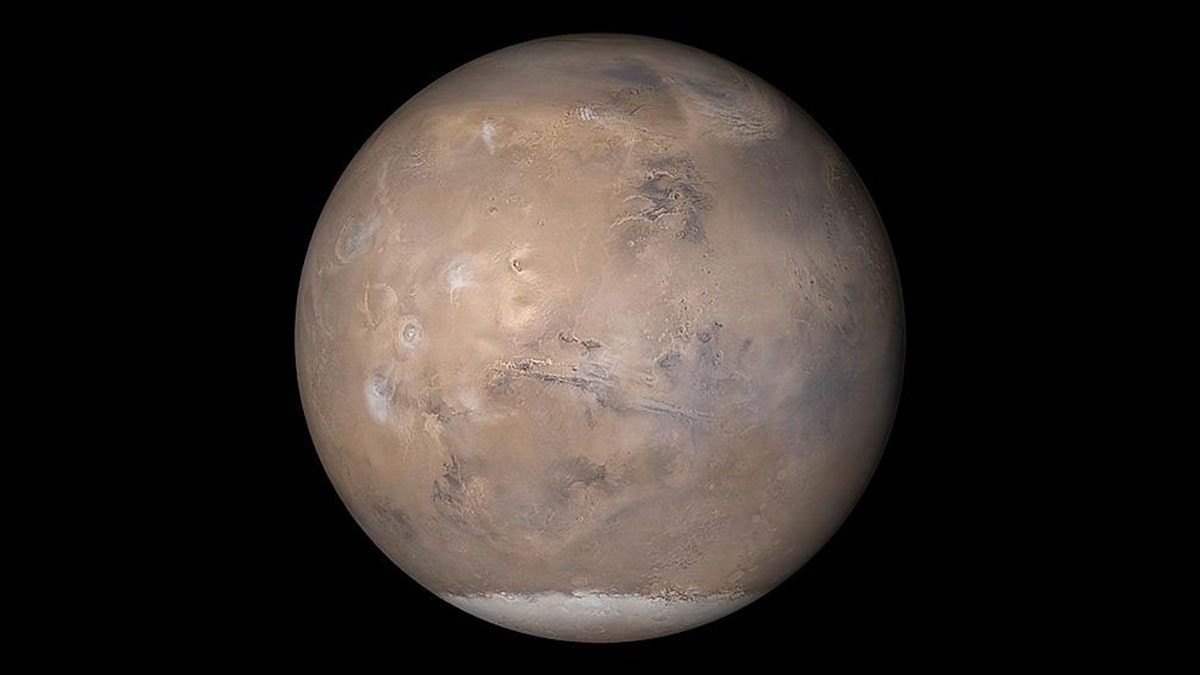
The view of Mars shown here was assembled from MOC daily global images obtained on May 12, 2003. (Credit: NASA/JPL/Malin Space Science Systems)
NASA announced that it already has selected the spot where its next Mars rover will land in the hunt for extraterrestrial life on the Red Planet.
"I have selected Jezero Crater," NASA's Associate Administrator Thomas Zurbuchen said on a conference call with the media. Other sites that had been in contention include Northeast Syrtis and Columbia Hills. In total, more than 60 locations were debated by the space agency over a five-year search.
“The landing site in Jezero Crater offers geologically rich terrain, with landforms reaching as far back as 3.6 billion years old that could potentially answer important questions in planetary evolution and astrobiology,” Zurbuchen said in a release on NASA's website, making the announcement. “Getting samples from this unique area will revolutionize how we think about Mars and its ability to harbor life.”
NASA UNVEILS STUNNING PICTURES OF GALAXY THAT LOOKS LIKE STAR TREK ENTERPRISE
In a tweet, NASA Administrator Jim Bridenstine said the area could potentially contain ancient molecules and "microbial life from billions of years ago."
"The rover, currently under construction at NASA’s Jet Propulsion Laboratory (JPL), will address high-priority science goals for Mars exploration, including key questions about the potential for ancient life on Mars," NASA wrote on its website.
As part of the mission, which is scheduled to launch in July 2020 at an estimated cost of more than $2 billion, according to Space News, the rover will not only look for signs of ancient life, but will get rock and soil samples from the Red Planet. It is expected to land on Feb. 18, 2021.
In a question-and-answer part of the call, Zurbuchen suggested that the samples may not be returned to Earth until the early 2030's.
In June, NASA made a stunning announcement, noting the Curiosity rover "found organic molecules in rocks from an ancient lake bed.” The rocks are billions of years old NASA said, before adding it had not found life on the planet.
The 28-mile-wide Jezero Crater is on the western edge of Isidis Planitia, a giant impact basin north of the planet's equator. NASA notes it is home to some of the "most scientifically interesting landscapes Mars has to offer," adding that it was once home to an ancient river delta, where ancient organic molecules and other signs of microbial life may be stored from billions of years ago.
There are at least five different types of rock in the Crater's lake-delta system, including clays and carbonates, which NASA says "have high potential to preserve signatures of past life." This geologic diversity is what attracted the Mars 2020 scientists to the landing spot, but also makes it difficult for the engineers to safely land the rover, thanks to numerous boulders, cliffs, depressions and rocks surrounding the region.
“The Mars community has long coveted the scientific value of sites such as Jezero Crater, and a previous mission contemplated going there, but the challenges with safely landing were considered prohibitive,” said Ken Farley, a JPL project scientist in a statement. “But what was once out of reach is now conceivable, thanks to the 2020 engineering team and advances in Mars entry, descent and landing technologies.”
NASA POSTS PHOTO OF 'CRASHED FLYING SAUCER FROM OUTER SPACE'
NASA has had some recent difficulties with two rovers already on the Red Planet, including the aforementioned Curiosity rover (which recently started drilling again) and the problematic Opportunity rover, which was severely impacted by a dust storm on the planet several months ago.
The space agency recently located the Opportunity rover, but has had trouble contacting it and there are fears that it may never respond. In its most recent update, NASA said it still has not received a signal from Opportunity, five months after it lost contact with the spacecraft.
“Nothing has been more difficult in robotic planetary exploration than landing on Mars,” Zurbuchen acknowledged.
However, he assured that the Mars 2020 engineering team has done tremendous amounts of work to ensure a safe landing on the Jezero Crater. "The team will continue their work to truly understand the TRN system and the risks involved, and we will review the findings independently to reassure we have maximized our chances for success,” he said.
Follow Chris Ciaccia on Twitter @Chris_Ciaccia



















